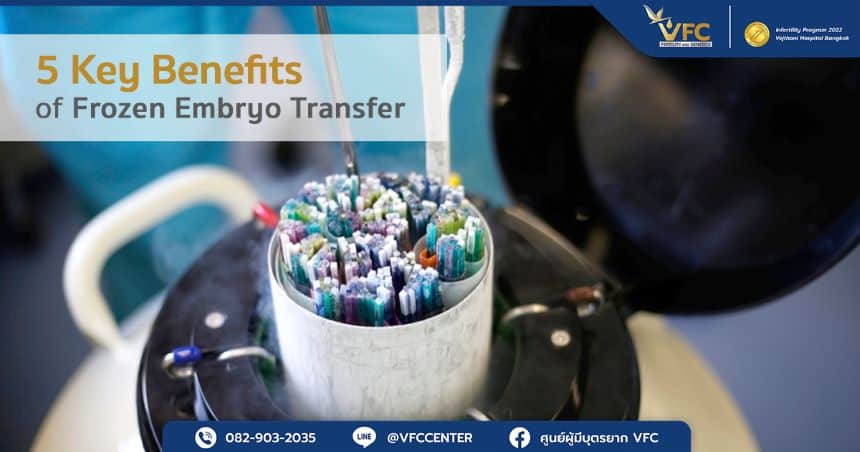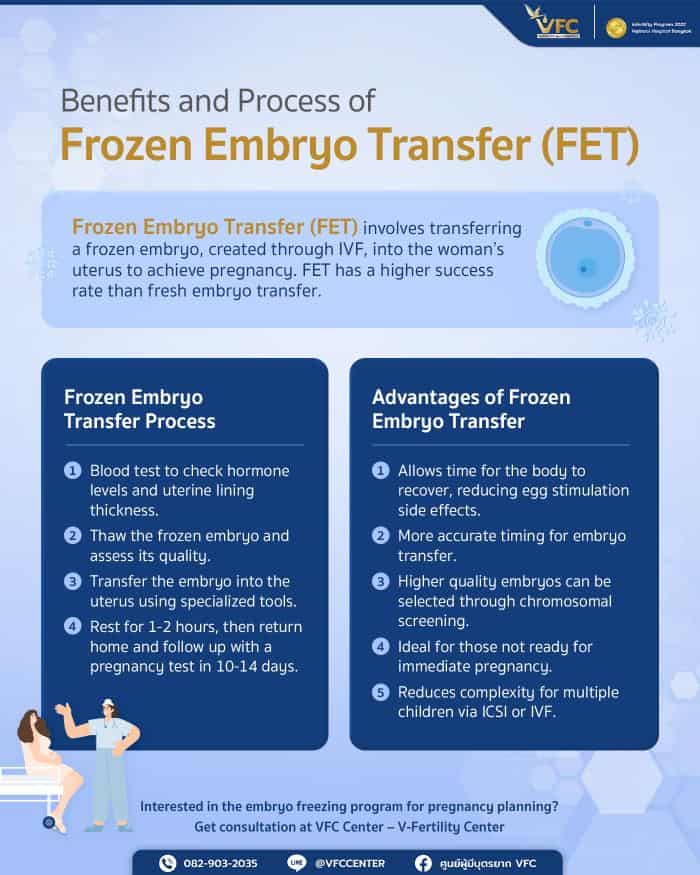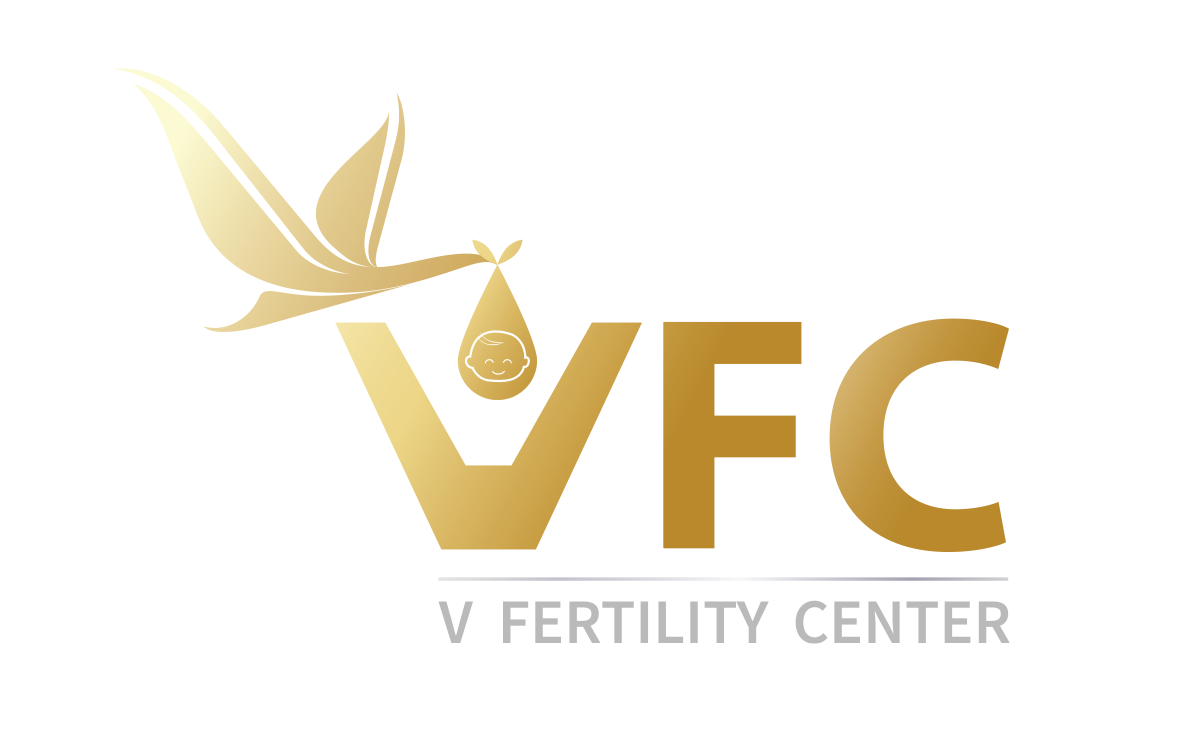
When discussing fertility treatments like ICSI or IVF, one of the key steps that significantly impacts pregnancy success is embryo transfer. Typically, a fresh embryo transfer is performed in the same cycle as egg retrieval. However, there’s a growing option that’s gaining popularity: Frozen Embryo Transfer (FET).
This option involves freezing high-quality embryos and transferring them at a more suitable time. This process can reduce certain risks and significantly improve the chances of a successful pregnancy.
What is Frozen Embryo Transfer (FET)?
Frozen Embryo Transfer (FET) refers to the process of transferring embryos that have been fertilized in the laboratory and then frozen using a method called vitrification (a glass-like cryopreservation technique). After thawing, the embryos are transferred into the woman’s uterus. Unlike fresh transfers that occur during the same cycle as egg stimulation, FET provides the flexibility to do the transfer at a time when the body is more prepared. Additionally, FET has been shown to have a higher pregnancy success rate compared to fresh transfers.
Steps for Frozen Embryo Transfer
- Health Check and Uterine Preparation: Blood tests are conducted to measure hormone levels, and an ultrasound is used to check the thickness and readiness of the uterine lining.
- Embryo Thawing: Embryos that have been frozen using vitrification are carefully thawed by removing the cryoprotectants and replacing them with warming solutions. The temperature is gradually increased to body temperature (37°C) over 20-30 minutes.
- Embryo Transfer: Once the embryos are thawed and their quality assessed, they are gently transferred into the woman’s uterus using specialized instruments to ensure they can implant successfully.
- Recovery After Transfer: After the procedure, the woman typically rests at the clinic for 1-2 hours. A follow-up blood test to check for pregnancy will be scheduled about 10-14 days later.

5 Benefits of Frozen Embryo Transfer
FET offers numerous advantages that can increase the chances of pregnancy success, including physical health benefits, improved process accuracy, and more flexibility in family planning. These benefits include:
1. Time for the Body to Recover, Reducing Risks from Egg Stimulation
After egg stimulation, women’s hormone levels fluctuate rapidly, which may lead to Ovarian Hyperstimulation Syndrome (OHSS) or other unwanted side effects. By opting for FET, the body has time to stabilize, reducing these risks and providing a better environment for embryo implantation.
2. More Accurate Timing for Embryo Transfer
With FET, the timing of the embryo transfer can be precisely planned. The uterine lining can be prepared in advance, ensuring the best conditions for embryo implantation, which increases the chances of pregnancy.
3. High-Quality Embryo Selection Through Genetic Screening
One of the key advantages of FET is the ability to select embryos with intact chromosomes. Through Preimplantation Genetic Testing for Monogenic Disorders (PGT-M), genetic abnormalities can be detected, reducing the risk of miscarriage and improving the success rates of pregnancy.
4. Facilitates Future Family Planning for Those Not Ready to Get Pregnant Immediately
Some couples choose to store eggs and embryos through IVF but are not ready for pregnancy at the time. By freezing embryos, couples can preserve their reproductive options and return to pregnancy planning when they are ready, offering flexibility.
5. Reduces Complications for Couples Wanting More Than One Child via ICSI or IVF
ICSI or IVF treatments require significant time, physical preparation, and financial investment. For couples planning to have more than one child, freezing embryos during a single cycle allows them to later use them in future transfers without undergoing multiple rounds of egg retrieval.

When is the Right Time for FET and How to Prepare?
Frozen Embryo Transfer is generally performed 1-2 months after egg retrieval and fertilization to allow the body to fully recover and the uterine lining to be adequately prepared. However, the timing can be adjusted based on the woman’s health and medical readiness.
Preparing for FET:
- Eat a protein-rich diet and foods high in vitamins A, B, C, and E. Avoid high-fat foods, raw foods, and fermented items.
- Avoid alcohol, smoking, and excessive caffeine.
- Ensure at least 7-8 hours of sleep per night to aid in body recovery.
- Avoid strenuous activities and extreme heat, such as hot baths or saunas, or heavy exercise.
- Engage in relaxing activities like meditation or yoga to reduce stress and maintain a calm mental state.
- Strictly follow the doctor’s instructions for hormone treatment to prepare the uterine lining.
Who is FET Suitable for?
FET is a great option for couples looking to expand their family using ICSI or IVF, offering numerous health and family planning advantages. It is particularly beneficial for:
- Those at risk of Ovarian Hyperstimulation Syndrome (OHSS) due to hormonal egg stimulation.
- Those who want time for recovery after egg retrieval to allow the uterine lining to return to normal.
- Couples who want to precisely time their embryo transfer when both physical health and fertility are optimal.
- Those wanting genetic screening of embryos before transfer.
- Those who cannot undergo a fresh transfer for medical or health reasons.
If you’re planning to do ICSI or IVF but are not ready to conceive immediately, VFC Center, the fertility technology center, is happy to offer consultations and care throughout every step. We provide options like egg freezing program in Bangkok, along with frozen embryo transfer, allowing couples to plan pregnancy and parenthood more conveniently in terms of readiness and health.
Contact or Book a Consultation:
VFC Center – V-Fertility Center
Hotline: 082-903-2035
LINE Official: @vfccenter

The team of specialists in obstetrics and gynecology and reproductive medicine





No Comments
Sorry, the comment form is closed at this time.